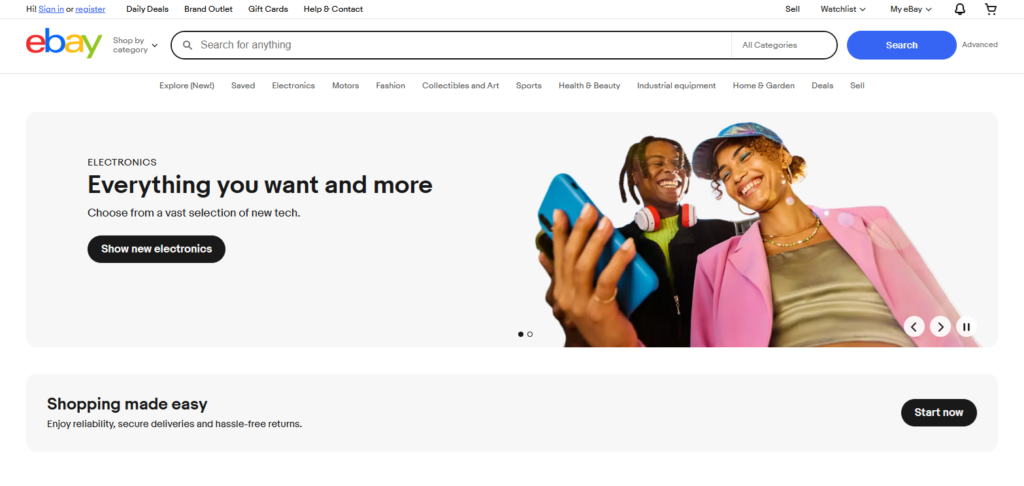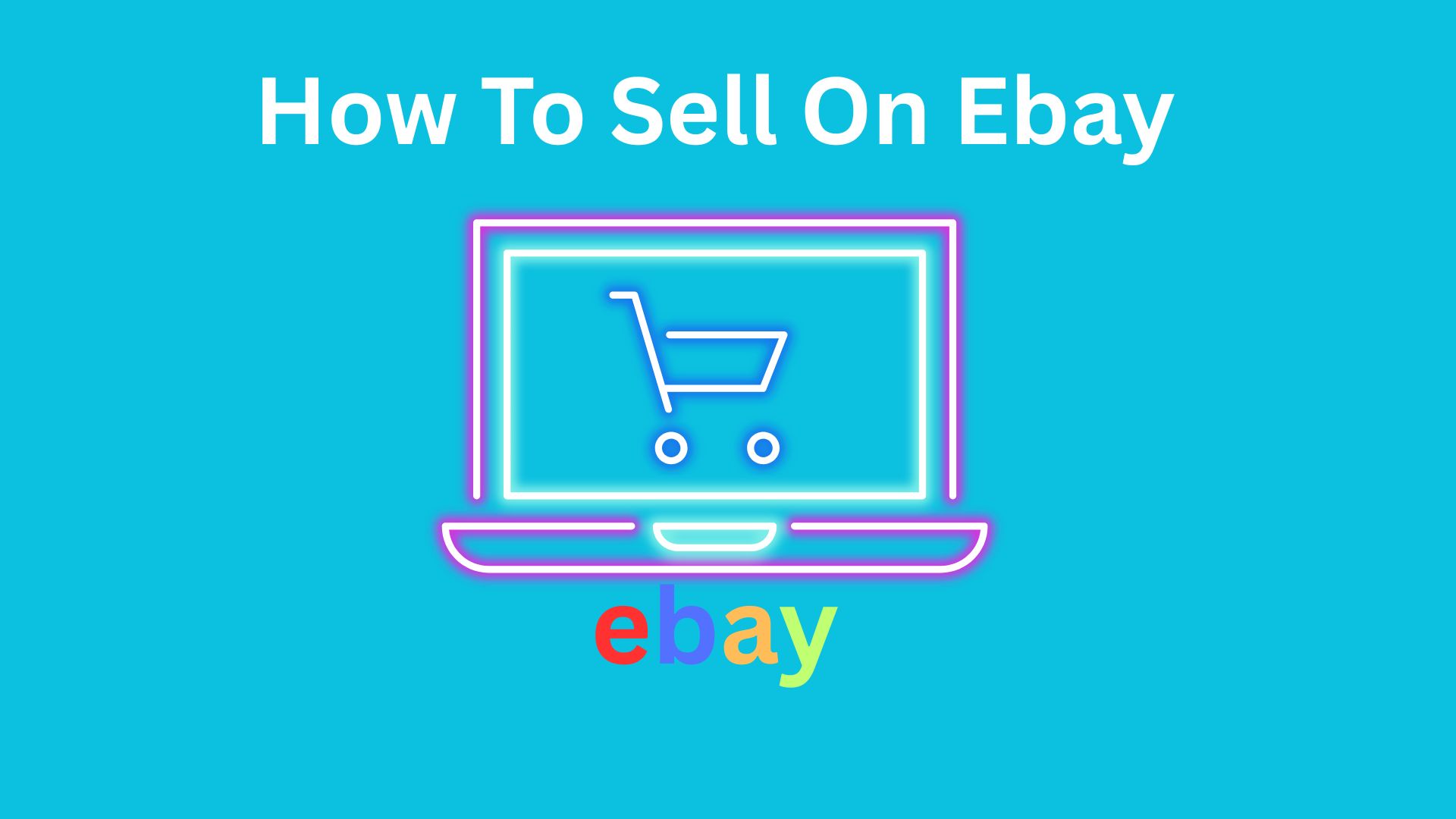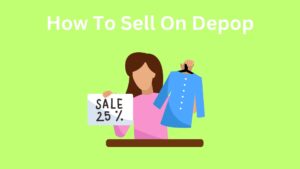Selling on eBay can be both a profitable side hustle and a full-time business—if you know how to do it right. Whether you’re decluttering your home or launching your own online store, learning how to sell on eBay the smart way can save you money, help you avoid common pitfalls, and set you up for long-term success.
I still remember the first item I listed on eBay back in 2016—a barely-used DSLR camera. I was a bit skeptical at first, wondering if anyone would actually buy it. But within 48 hours, it sold at a higher price than I expected. Since then, I’ve sold everything from vintage sneakers to discontinued electronics and built a steady side income stream. Over the years, I’ve also consulted for small businesses looking to start selling on eBay, helping them navigate listings, fees, and shipping with confidence.
With nearly a decade of hands-on experience in the e-commerce world and a background in digital marketing, I’ve written this guide for beginners to give you a comprehensive, realistic, and actionable roadmap to becoming a successful seller on eBay. Whether you’re selling your first item or looking to scale an eBay store, this article will give you all the tools you need to succeed.
Key Takeaways
- Learn how to set up your eBay account and create optimized listings
- Understand eBay fees, including the final value fee and cost to sell
- Discover how to ship products efficiently and offer free shipping strategically
- Avoid common mistakes that many new eBay sellers make
- Get actionable tips to help you become a successful eBay seller
According to a 2024 Statista report, eBay has over 134 million active buyers globally—making it one of the top platforms to sell online. eBay’s own internal research shows that 78% of small business sellers saw growth in their sales within the first 12 months of launching their eBay business.
Whether you want to sell a few unused gadgets or build an eBay store that competes with the pros, understanding how eBay works from the ground up is crucial. So let’s dive into this step-by-step guide for beginners and learn how to sell like a pro.
What Is eBay?

eBay is one of the world’s largest and most trusted online marketplaces, allowing individuals and businesses to buy and sell directly to consumers around the globe. Launched in 1995, eBay started as a simple auction site but has evolved into a powerful e-commerce platform where users can sell almost anything—from electronics and clothing to collectibles and industrial equipment.
Unlike other marketplaces, eBay offers both auction-style and fixed-price listings, giving sellers flexibility in how they present and sell their items. eBay allows you to create detailed product pages, communicate with buyers, and manage orders all in one place.
Setting Up Your eBay Account the Right Way
Before you start selling on eBay, you need to set up a solid foundation—your eBay account.
Create Your eBay Account
Visit ebay.com and click “Register.” You can choose between a personal or business account. If you’re only selling a few things, a personal account is fine. But if you plan to turn this into a side hustle or full business, a business account provides additional features and branding options.
💡 Pro Tip: Choose a professional eBay username that reflects what you sell. A name like “GadgetHubPro” builds trust more than “cooldude1993.”
Verify and Set Up Your Profile
After registering, eBay will ask for identity verification and payment preferences. This ensures that your eBay transactions are secure. Link a checking account for eBay managed payments—this allows you to receive your earnings directly into your bank.
Set your preferred handling time, return policy, and shipping methods. These decisions affect your rating on eBay, which in turn influences your visibility in search results.
Researching What to Sell on eBay
Choosing the right products to sell is crucial. Not everything sells well, and some items on eBay might have too much competition.
Use eBay’s Search and Sold Listings
Search for items similar to yours and use the “Sold Listings” filter to see what actually sells and at what price. This gives you real-world market data.
According to eBay, items with a sell-through rate above 50% are considered strong performers. You can also search for products on eBay using Terapeak (available free for most sellers), which provides deeper analytics.
Find Profitable Items to Sell
Focus on lightweight, easy-to-ship items at first—think phones, books, fashion accessories. Some of the best things to sell include branded electronics, collectibles, vintage items, and niche hobby goods.
💡 Real Experience: I once sold a discontinued video game guidebook for $85. I had bought it for $5 at a garage sale. Niche items can surprise you.
Creating a Successful eBay Listing
Your eBay listing is your digital storefront. A great listing not only attracts buyers but also ensures that you’re selling efficiently and with fewer questions or returns.
Optimize Your Title and Description
Use clear, keyword-rich titles. Instead of “Nice iPhone,” write “Apple iPhone 12 Pro Max 128GB – Unlocked – Excellent Condition.” Your title should match what a buyer might search eBay for.
In the description, include all relevant details: condition, model number, flaws, shipping info, and return policy. Transparency reduces disputes.
Use High-Quality Photos
eBay allows up to 12 photos per listing for free. Use natural light, multiple angles, and close-ups of any defects. Photos help ebay customers build trust with your item and reduce chances of return.
💡 eBay Selling Tip: Keep a white or neutral background for all photos—it’s easier on the eyes and helps your product stand out.
Pricing Your Product on eBay
Getting the price on eBay right can make or break your sale.
Fixed Price vs Auction
- Fixed Price (Buy It Now): Great for high-demand or replenishable items.
- Auction: Ideal for rare, collectible, or hard-to-price goods.
Set competitive prices by checking what similar items sold for. Include shipping in your calculations. eBay fees (like the final value fee) and shipping materials add to your cost to sell.
💡 Example: If you’re selling a $100 item and eBay takes 13% + $0.30, and shipping costs you $6, your actual net profit is about $80.70.
Shipping and Handling Tips
Shipping on eBay can seem tricky, but it gets easy with practice.
Offer Free Shipping When Possible
When you offer free shipping, you boost your listing in search results and attract more buyers. Just make sure to factor it into your price.
Calculate and Display Shipping Cost
If you can’t offer free, use eBay’s shipping calculator to add real-time shipping cost based on the buyer’s location. This transparency helps manage expectations.
💡 Personal Insight: I once lost a $20 profit on an international sale because I underestimated postage. Always double-check your shipping cost.
Understanding eBay Fees
Knowing the costs of selling on eBay helps you price effectively.
Final Value Fees
This is eBay’s commission—typically 10-15% of the sale price, including shipping. It’s automatically deducted from your payout.
Additional Fees
Other selling fees might include listing upgrades (e.g., bold fonts, subtitle), international fees, or fees for high-volume listings on eBay.
💡 Fact: According to eBay’s 2024 Seller Report, the average final value fee is around 12.9% + $0.30 for most categories.
Managing Customer Service and Returns
Great customer service helps you build a reputation as a successful eBay seller.
Handle Questions Promptly
Respond to messages quickly. Use the eBay app to stay notified and reply in real time.
Deal with Returns Gracefully
eBay provides return labels and protection, but how you handle returns affects your seller on eBay status. A clear, fair return policy increases buyer trust.
Scaling Your eBay Business
Once you’ve made a few sales, it’s time to treat this like a real ebay business.
Open an eBay Store
An eBay store gives you branding, discounted fees, and promotional tools. Plans start at $4.95/month for the basic tier.
List More Products and Track Performance
Use tools like Seller Hub to optimize your eBay listings, manage inventory, and evaluate what’s performing well. The more consistently you list products on eBay, the more traffic you’ll attract.
💡 Tip from Experience: I increased my revenue by 40% just by reducing my handling time from 3 days to 1 day. Fast shipping boosts your trust rating.
Even with the best intentions, selling on eBay comes with learning curves. Here are some common hurdles—and how to overcome them.
“I Can’t Sell on eBay” — Account Restrictions
It’s not unusual to hear, “I can’t sell on eBay.” That’s often due to new account limitations or policy violations. eBay may temporarily limit your listings until you’ve established a reliable selling history. Stick to the rules, ship promptly, and maintain communication to build credibility.
💡 Note: eBay doesn’t allow the sale of prohibited items (e.g., counterfeit goods, certain electronics). Always check eBay’s restricted item list before creating a listing.
Managing Difficult Buyers
No matter how good your product or communication is, sometimes you’ll deal with problematic buyers. Some may dispute legitimate transactions or leave unfair feedback. Use the eBay Resolution Center to resolve issues professionally.
Pro Insight: Document all communication. If a buyer becomes abusive or breaks rules, eBay can help by reviewing your case and protecting your seller rating.
How to Make Your eBay Listings Stand Out
The platform is competitive—so how do you get your product on eBay noticed?
Use Storytelling in Descriptions
While specs matter, don’t be afraid to add flair. A description like “This camera was my travel buddy for two years, and it’s still capturing memories beautifully,” builds an emotional connection.
Master the Art of Keywords
Incorporate keyword variations naturally. For example:
- Instead of repeating “Bluetooth speaker,” use “wireless audio device,” “portable sound system,” or “Bluetooth boombox.”
- Avoid stuffing. Use synonyms to optimize your eBay listings without penalties.
💡 eBay selling guide insight: Search engines index your eBay listing, so using natural language helps you sell on eBay without violating policies or alienating buyers.
Advanced eBay Selling Tips from Experience
After years of running a thriving eBay side hustle, here are actionable, high-ROI tips most beginners overlook.
Batch Your Listings for Efficiency
Create 5–10 listings at once using eBay’s bulk listing tool. This saves time and keeps your store active, which eBay frequently rewards with better search placement.
Promote Your Listings
Use “Promoted Listings” to increase visibility. While you pay a small fee per sale, the boost in traffic often offsets the cost—especially in saturated categories.
Build a Repeat Buyer Base
Add a personal note to packages, offer discounts on future purchases, and respond quickly to messages. Happy eBay buyers come back.
💡 Stat: According to a 2023 eBay Seller Survey, repeat buyers spend 37% more over time than first-time buyers.
Selling Internationally: Is It Worth It?
Expanding your ebay business to global customers sounds great—but it comes with challenges.
Pros and Cons of International Sales
Pros:
- Larger customer base
- Higher prices on niche items
- Faster turnover of inventory
Cons:
- Higher shipping cost
- Complex customs forms
- Greater risk of return disputes
If you offer free shipping, consider limiting it to domestic buyers and using calculated shipping for international ones.
💡 Real Experience: I once sold an item to a collector in Germany for twice what it would’ve earned in the U.S.—but I nearly lost money due to unaccounted customs fees. Always factor in international shipping costs when pricing.
Should You Open an eBay Store?
Once you consistently sell 50+ items per month, an eBay store becomes not just useful—but essential.
eBay Store Benefits
- Reduced final value fees
- Access to promotional tools
- A branded online store URL
- Monthly credits for promoted listings
It also gives your ebay account a professional feel, boosting buyer trust and signaling that you’re in this for the long run.
The Long-Term Game: Turning eBay Into a Business
If you’ve sold dozens—or hundreds—of things on eBay, it’s time to think about scalability.
Treat It Like a Business
Track expenses, profits, selling fees, and reinvest wisely. eBay even offers analytics to help you assess what’s working.
Set up an eBay bookkeeping system using tools like QuickBooks, GoDaddy Bookkeeping, or a custom Google Sheets dashboard. Staying organized ensures you’re always aware of the true cost to sell each item.
Reinvest Your Profits
Buy inventory that’s proven to sell well. Some of the things to sell on eBay include refurbished electronics, bulk wholesale goods, and vintage clothing.
💡 Unique Tip: Visit estate sales, liquidation stores, or Facebook Marketplace to find profitable items to sell at a fraction of their value.
Knowing When to Pivot or Scale
There’s no shame in reevaluating your strategy. If eBay doesn’t yield the margins or volume you want, you can scale down—or expand to platforms like eBay such as Mercari or Poshmark.
💡 Flexibility is key: The ebay depends model on consistent service, smart sourcing, and adapting to changing demand.
Conclusion: Selling on eBay Is a Skill You Can Master
Whether you’re trying to declutter your home or launch a full-fledged ebay business, knowing how to sell on eBay effectively can unlock consistent income. It’s not just about uploading a photo and slapping on a price — it’s about understanding what ebay offers, what your buyers want, and how to present your listings in a way that builds trust and drives sales.
From setting up your ebay account and researching the best things to sell, to calculating shipping cost and promoting your ebay store, you now have a comprehensive roadmap. You’ve also learned how to troubleshoot common issues, scale your efforts, and treat selling like a real business.
Final Thought: eBay isn’t just a marketplace—it’s a launchpad. The more you learn, adapt, and engage, the more successful your journey will be. And remember, even the most successful eBay seller started with their first item you want to sell. So don’t wait. Choose your first product, and start selling on eBay today.
Explore More Articles
Frequently Asked Questions: How to Sell on eBay
1. Is it free to sell on eBay?
Not entirely. While you can sell on eBay for free up to 250 listings per month, ebay charges a final value fee (usually around 12.9%) when your item sells. There may also be fees for extra features or Promoted Listings.
2. What are the best things to sell on eBay for beginners?
Start with items you already own—especially electronics, vintage clothing, books, and collectibles. These are typically easy to sell and give you experience without upfront costs. Over time, explore other profitable items to sell based on demand.
3. Can I sell on eBay without having a PayPal account?
Yes. Thanks to eBay managed payments, you no longer need PayPal. eBay provides direct payment options and deposits funds straight into your bank account.
4. How do I set up my eBay account to start selling?
Go to eBay.com and set up an eBay account. Choose a username, add your payment info, and verify your email. Once done, you’re able to sell by clicking “Sell” at the top of the homepage.
5. What is the handling time on eBay and why does it matter?
Handling time refers to how quickly you ship after a sale. Faster handling (1 day or less) can boost your rating on eBay and improve visibility. Delayed shipping can lead to negative feedback or penalties.
6. How does shipping on eBay work?
Shipping on eBay is customizable. You can choose flat-rate, calculated, or offer free shipping. eBay even integrates USPS and other carrier tools, making it easier to print labels and track packages.
7. Can I sell directly to buyers on eBay?
Yes. eBay is a marketplace that allows you to sell directly to global customers. While communication happens via eBay’s platform, the entire transaction is between you and the ebay buyer.
8. What happens if I don’t fulfill a transaction or cancel a sale?
This could negatively impact your seller on eBay metrics. Too many cancellations may limit your listings on eBay, reduce visibility, or even lead to temporary suspension.
9. How can I optimize my eBay listings for search?
Use relevant keywords, clear images, compelling descriptions, and accurate categories. To optimize your eBay listings, think like your customer: what would you type in to search eBay?
10. What if I want to grow beyond selling a few items?
Once you’ve sold several items on eBay, consider creating a branded ebay store and turning your hustle into a full-fledged business on eBay. With the right tools and mindset, ebay can be a great long-term income source.




